2018 BUICK LACROSSE run flat
[x] Cancel search: run flatPage 98 of 362
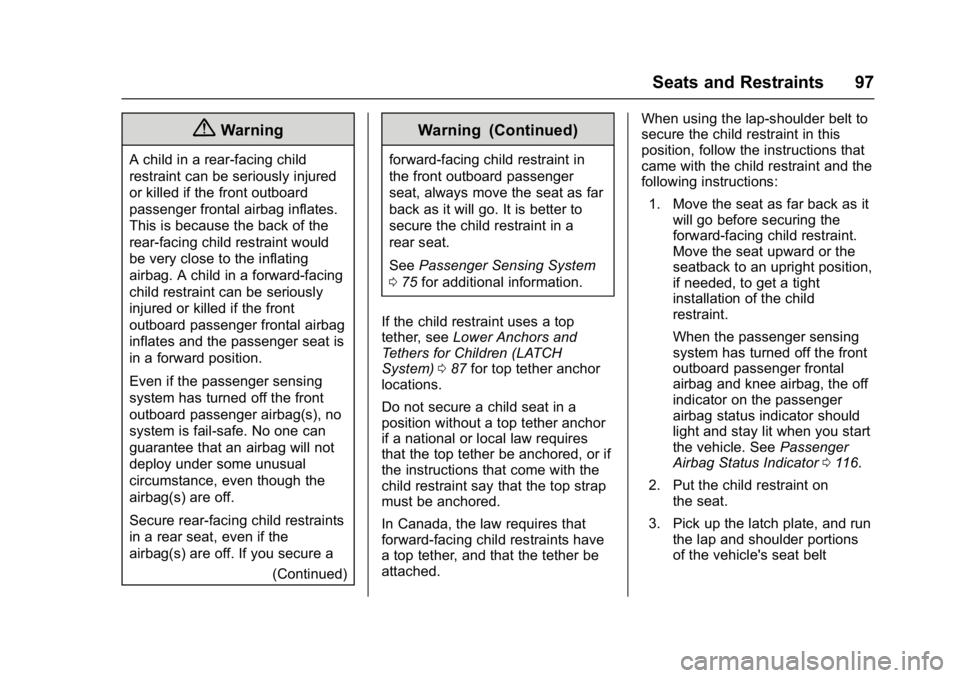
Buick LaCrosse Owner Manual (GMNA-Localizing-U.S./Canada-10999169) -
2018 - crc - 3/28/17
Seats and Restraints 97
{Warning
A child in a rear-facing child
restraint can be seriously injured
or killed if the front outboard
passenger frontal airbag inflates.
This is because the back of the
rear-facing child restraint would
be very close to the inflating
airbag. A child in a forward-facing
child restraint can be seriously
injured or killed if the front
outboard passenger frontal airbag
inflates and the passenger seat is
in a forward position.
Even if the passenger sensing
system has turned off the front
outboard passenger airbag(s), no
system is fail-safe. No one can
guarantee that an airbag will not
deploy under some unusual
circumstance, even though the
airbag(s) are off.
Secure rear-facing child restraints
in a rear seat, even if the
airbag(s) are off. If you secure a(Continued)
Warning (Continued)
forward-facing child restraint in
the front outboard passenger
seat, always move the seat as far
back as it will go. It is better to
secure the child restraint in a
rear seat.
SeePassenger Sensing System
0 75 for additional information.
If the child restraint uses a top
tether, see Lower Anchors and
Tethers for Children (LATCH
System) 087 for top tether anchor
locations.
Do not secure a child seat in a
position without a top tether anchor
if a national or local law requires
that the top tether be anchored, or if
the instructions that come with the
child restraint say that the top strap
must be anchored.
In Canada, the law requires that
forward-facing child restraints have
a top tether, and that the tether be
attached. When using the lap-shoulder belt to
secure the child restraint in this
position, follow the instructions that
came with the child restraint and the
following instructions:
1. Move the seat as far back as it will go before securing the
forward-facing child restraint.
Move the seat upward or the
seatback to an upright position,
if needed, to get a tight
installation of the child
restraint.
When the passenger sensing
system has turned off the front
outboard passenger frontal
airbag and knee airbag, the off
indicator on the passenger
airbag status indicator should
light and stay lit when you start
the vehicle. See Passenger
Airbag Status Indicator 0116.
2. Put the child restraint on the seat.
3. Pick up the latch plate, and run the lap and shoulder portions
of the vehicle's seat belt
Page 165 of 362

Buick LaCrosse Owner Manual (GMNA-Localizing-U.S./Canada-10999169) -
2018 - crc - 3/28/17
164 Driving and Operating
Warning (Continued)
After driving through a large
puddle of water or a car/vehicle
wash, lightly apply the brake
pedal until the brakes work
normally.
Flowing or rushing water creates
strong forces. Driving through
flowing water could cause the
vehicle to be carried away. If this
happens, you and other vehicle
occupants could drown. Do not
ignore police warnings and be
very cautious about trying to drive
through flowing water.
Hydroplaning
Hydroplaning is dangerous. Water
can build up under the vehicle's
tires so they actually ride on the
water. This can happen if the road is
wet enough and you are going fast
enough. When the vehicle is
hydroplaning, it has little or no
contact with the road.There is no hard and fast rule about
hydroplaning. The best advice is to
slow down when the road is wet.
Other Rainy Weather Tips
Besides slowing down, other wet
weather driving tips include:
.
Allow extra following distance.
. Pass with caution.
. Keep windshield wiping
equipment in good shape.
. Keep the windshield washer fluid
reservoir filled.
. Have good tires with proper
tread depth. See Tires0259.
. Turn off cruise control.
Hill and Mountain Roads
Driving on steep hills or through
mountains is different than driving
on flat or rolling terrain. Tips include:
.
Keep the vehicle serviced and in
good shape.
. Check all fluid levels and brakes,
tires, cooling system, and
transmission. .
Shift to a lower gear when going
down steep or long hills.
{Warning
Using the brakes to slow the
vehicle on a long downhill slope
can cause brake overheating, can
reduce brake performance, and
could result in a loss of braking.
Shift the transmission to a lower
gear to let the engine assist the
brakes on a steep downhill slope.
{Warning
Coasting downhill in N (Neutral)
or with the ignition off is
dangerous. This can cause
overheating of the brakes and
loss of steering. Always have the
engine running and the vehicle
in gear.
. Drive at speeds that keep the
vehicle in its own lane. Do not
swing wide or cross the
center line.
Page 224 of 362
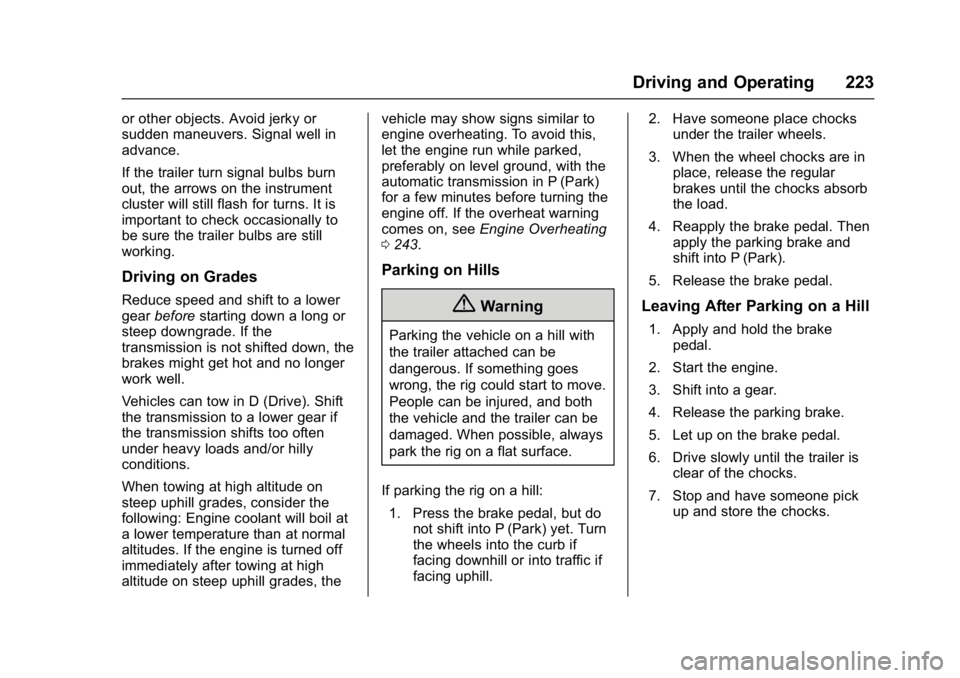
Buick LaCrosse Owner Manual (GMNA-Localizing-U.S./Canada-10999169) -
2018 - crc - 3/28/17
Driving and Operating 223
or other objects. Avoid jerky or
sudden maneuvers. Signal well in
advance.
If the trailer turn signal bulbs burn
out, the arrows on the instrument
cluster will still flash for turns. It is
important to check occasionally to
be sure the trailer bulbs are still
working.
Driving on Grades
Reduce speed and shift to a lower
gearbefore starting down a long or
steep downgrade. If the
transmission is not shifted down, the
brakes might get hot and no longer
work well.
Vehicles can tow in D (Drive). Shift
the transmission to a lower gear if
the transmission shifts too often
under heavy loads and/or hilly
conditions.
When towing at high altitude on
steep uphill grades, consider the
following: Engine coolant will boil at
a lower temperature than at normal
altitudes. If the engine is turned off
immediately after towing at high
altitude on steep uphill grades, the vehicle may show signs similar to
engine overheating. To avoid this,
let the engine run while parked,
preferably on level ground, with the
automatic transmission in P (Park)
for a few minutes before turning the
engine off. If the overheat warning
comes on, see
Engine Overheating
0 243.
Parking on Hills
{Warning
Parking the vehicle on a hill with
the trailer attached can be
dangerous. If something goes
wrong, the rig could start to move.
People can be injured, and both
the vehicle and the trailer can be
damaged. When possible, always
park the rig on a flat surface.
If parking the rig on a hill: 1. Press the brake pedal, but do not shift into P (Park) yet. Turn
the wheels into the curb if
facing downhill or into traffic if
facing uphill. 2. Have someone place chocks
under the trailer wheels.
3. When the wheel chocks are in place, release the regular
brakes until the chocks absorb
the load.
4. Reapply the brake pedal. Then apply the parking brake and
shift into P (Park).
5. Release the brake pedal.
Leaving After Parking on a Hill
1. Apply and hold the brake pedal.
2. Start the engine.
3. Shift into a gear.
4. Release the parking brake.
5. Let up on the brake pedal.
6. Drive slowly until the trailer is clear of the chocks.
7. Stop and have someone pick up and store the chocks.
Page 281 of 362
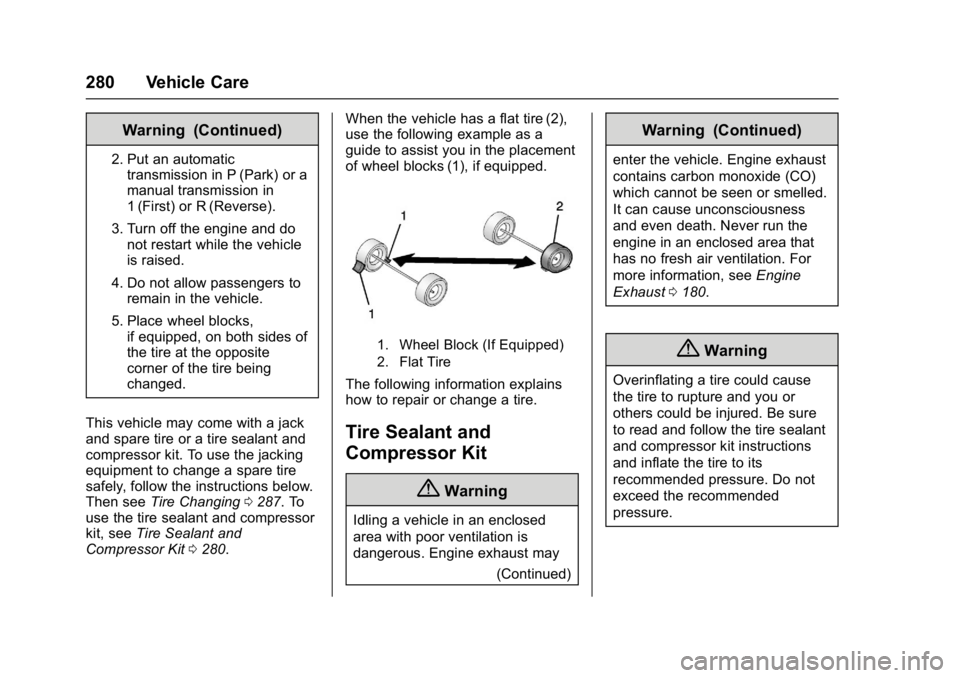
Buick LaCrosse Owner Manual (GMNA-Localizing-U.S./Canada-10999169) -
2018 - crc - 3/28/17
280 Vehicle Care
Warning (Continued)
2. Put an automatictransmission in P (Park) or a
manual transmission in
1 (First) or R (Reverse).
3. Turn off the engine and do not restart while the vehicle
is raised.
4. Do not allow passengers to remain in the vehicle.
5. Place wheel blocks, if equipped, on both sides of
the tire at the opposite
corner of the tire being
changed.
This vehicle may come with a jack
and spare tire or a tire sealant and
compressor kit. To use the jacking
equipment to change a spare tire
safely, follow the instructions below.
Then see Tire Changing 0287. To
use the tire sealant and compressor
kit, see Tire Sealant and
Compressor Kit 0280. When the vehicle has a flat tire (2),
use the following example as a
guide to assist you in the placement
of wheel blocks (1), if equipped.
1. Wheel Block (If Equipped)
2. Flat Tire
The following information explains
how to repair or change a tire.
Tire Sealant and
Compressor Kit
{Warning
Idling a vehicle in an enclosed
area with poor ventilation is
dangerous. Engine exhaust may
(Continued)
Warning (Continued)
enter the vehicle. Engine exhaust
contains carbon monoxide (CO)
which cannot be seen or smelled.
It can cause unconsciousness
and even death. Never run the
engine in an enclosed area that
has no fresh air ventilation. For
more information, seeEngine
Exhaust 0180.
{Warning
Overinflating a tire could cause
the tire to rupture and you or
others could be injured. Be sure
to read and follow the tire sealant
and compressor kit instructions
and inflate the tire to its
recommended pressure. Do not
exceed the recommended
pressure.
Page 284 of 362
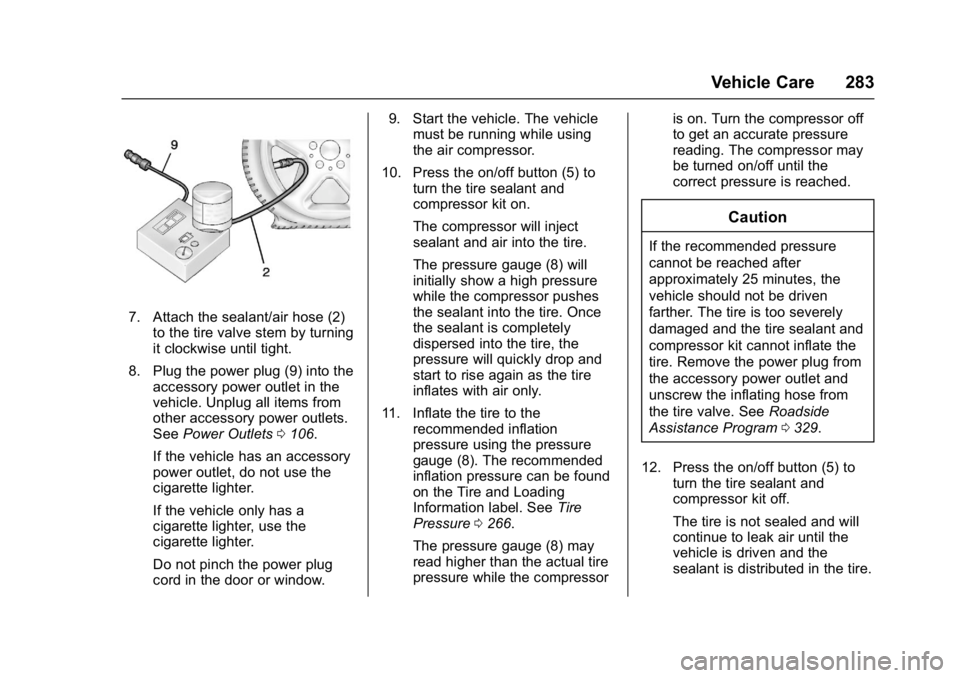
Buick LaCrosse Owner Manual (GMNA-Localizing-U.S./Canada-10999169) -
2018 - crc - 3/28/17
Vehicle Care 283
7. Attach the sealant/air hose (2)to the tire valve stem by turning
it clockwise until tight.
8. Plug the power plug (9) into the accessory power outlet in the
vehicle. Unplug all items from
other accessory power outlets.
See Power Outlets 0106.
If the vehicle has an accessory
power outlet, do not use the
cigarette lighter.
If the vehicle only has a
cigarette lighter, use the
cigarette lighter.
Do not pinch the power plug
cord in the door or window. 9. Start the vehicle. The vehicle
must be running while using
the air compressor.
10. Press the on/off button (5) to turn the tire sealant and
compressor kit on.
The compressor will inject
sealant and air into the tire.
The pressure gauge (8) will
initially show a high pressure
while the compressor pushes
the sealant into the tire. Once
the sealant is completely
dispersed into the tire, the
pressure will quickly drop and
start to rise again as the tire
inflates with air only.
11. Inflate the tire to the recommended inflation
pressure using the pressure
gauge (8). The recommended
inflation pressure can be found
on the Tire and Loading
Information label. See Tire
Pressure 0266.
The pressure gauge (8) may
read higher than the actual tire
pressure while the compressor is on. Turn the compressor off
to get an accurate pressure
reading. The compressor may
be turned on/off until the
correct pressure is reached.
Caution
If the recommended pressure
cannot be reached after
approximately 25 minutes, the
vehicle should not be driven
farther. The tire is too severely
damaged and the tire sealant and
compressor kit cannot inflate the
tire. Remove the power plug from
the accessory power outlet and
unscrew the inflating hose from
the tire valve. See
Roadside
Assistance Program 0329.
12. Press the on/off button (5) to turn the tire sealant and
compressor kit off.
The tire is not sealed and will
continue to leak air until the
vehicle is driven and the
sealant is distributed in the tire.
Page 287 of 362
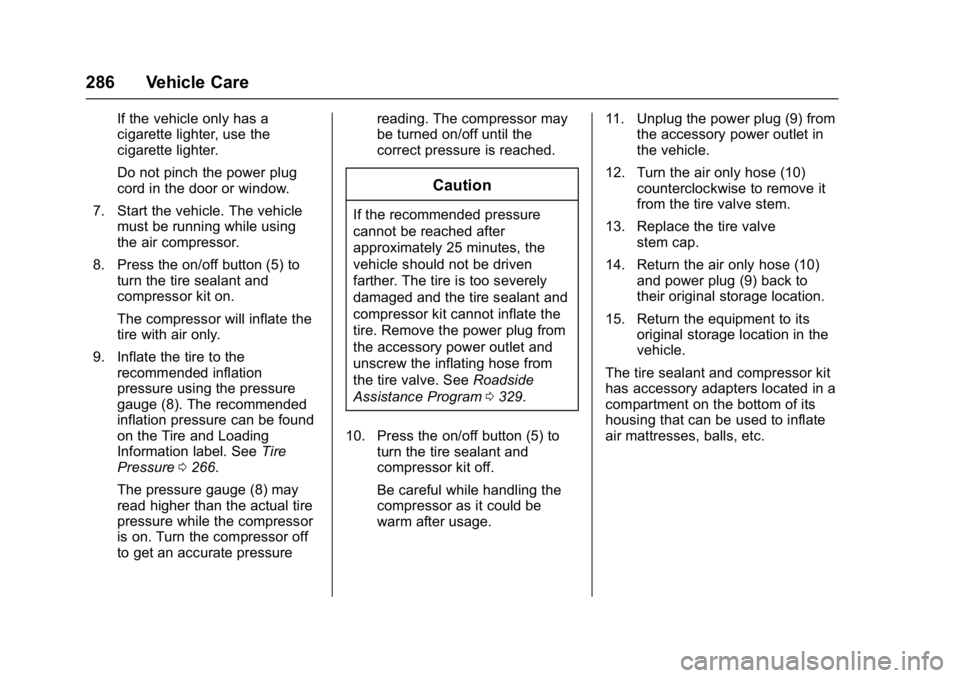
Buick LaCrosse Owner Manual (GMNA-Localizing-U.S./Canada-10999169) -
2018 - crc - 3/28/17
286 Vehicle Care
If the vehicle only has a
cigarette lighter, use the
cigarette lighter.
Do not pinch the power plug
cord in the door or window.
7. Start the vehicle. The vehicle must be running while using
the air compressor.
8. Press the on/off button (5) to turn the tire sealant and
compressor kit on.
The compressor will inflate the
tire with air only.
9. Inflate the tire to the recommended inflation
pressure using the pressure
gauge (8). The recommended
inflation pressure can be found
on the Tire and Loading
Information label. See Tire
Pressure 0266.
The pressure gauge (8) may
read higher than the actual tire
pressure while the compressor
is on. Turn the compressor off
to get an accurate pressure reading. The compressor may
be turned on/off until the
correct pressure is reached.
Caution
If the recommended pressure
cannot be reached after
approximately 25 minutes, the
vehicle should not be driven
farther. The tire is too severely
damaged and the tire sealant and
compressor kit cannot inflate the
tire. Remove the power plug from
the accessory power outlet and
unscrew the inflating hose from
the tire valve. See
Roadside
Assistance Program 0329.
10. Press the on/off button (5) to turn the tire sealant and
compressor kit off.
Be careful while handling the
compressor as it could be
warm after usage. 11. Unplug the power plug (9) from
the accessory power outlet in
the vehicle.
12. Turn the air only hose (10) counterclockwise to remove it
from the tire valve stem.
13. Replace the tire valve stem cap.
14. Return the air only hose (10) and power plug (9) back to
their original storage location.
15. Return the equipment to its original storage location in the
vehicle.
The tire sealant and compressor kit
has accessory adapters located in a
compartment on the bottom of its
housing that can be used to inflate
air mattresses, balls, etc.
Page 354 of 362

Buick LaCrosse Owner Manual (GMNA-Localizing-U.S./Canada-10999169) -
2018 - crc - 3/28/17
Index 353
DrivingAssistance Systems . . . . . . . . . . 207
Characteristics and
Towing Tips . . . . . . . . . . . . . . . . . 221
Defensive . . . . . . . . . . . . . . . . . . . . . 161
Drunk . . . . . . . . . . . . . . . . . . . . . . . . . 161
For Better Fuel Economy . . . . . . . 26
Hill and Mountain Roads . . . . . . 164
If the Vehicle is Stuck . . . . . . . . . 166
Loss of Control . . . . . . . . . . . . . . . 163
Off-Road Recovery . . . . . . . . . . . 162
Vehicle Load Limits . . . . . . . . . . . 166
Wet Roads . . . . . . . . . . . . . . . . . . . 163
Winter . . . . . . . . . . . . . . . . . . . . . . . . 165
Dual Automatic Climate Control System . . . . . . . . . . . . . . . . 152
E
Electric Parking Brake . . . . . . . . . . 188
Electric Parking Brake Light . . . . 119
Electrical Equipment,
Add-On . . . . . . . . . . . . . . . . . . . . . . . 226
Electrical System Engine Compartment FuseBlock . . . . . . . . . . . . . . . . . . . . . . . . 254
Fuses and Circuit Breakers . . . 253
Instrument Panel Fuse
Block . . . . . . . . . . . . . . . . . . . . . . . . 257
Overload . . . . . . . . . . . . . . . . . . . . . 253 Emergency
OnStar . . . . . . . . . . . . . . . . . . . . . . . 340
Energy Information . . . . . . . . . . . . . 126
Engine Air Cleaner/Filter . . . . . . . . . . . . . 238
Check Light (MalfunctionIndicator) . . . . . . . . . . . . . . . . . . . . .117
Compartment Overview . . . . . . . 231
Coolant Temperature Gauge . . . . . . . . . . . . . . . . . . . . . . .114
Coolant Temperature
Warning Light . . . . . . . . . . . . . . . 122
Cooling System . . . . . . . . . . . . . . . 239
Drive Belt Routing . . . . . . . . . . . . 324
Exhaust . . . . . . . . . . . . . . . . . . . . . . 180
Heater . . . . . . . . . . . . . . . . . . . . . . . . 175
Oil Life System . . . . . . . . . . . . . . . 237
Oil Pressure Light . . . . . . . . . . . . 123
Overheated Protection Operating Mode . . . . . . . . . . . . . 244
Overheating . . . . . . . . . . . . . . . . . . 243
Power Messages . . . . . . . . . . . . . 132
Running While Parked . . . . . . . . 180
Starting . . . . . . . . . . . . . . . . . . . . . . . 172
Entry Lighting . . . . . . . . . . . . . . . . . . . 149
Equipment, Towing . . . . . . . . . . . . . 225
Event Data Recorders . . . . . . . . . . 337
Exit Lighting . . . . . . . . . . . . . . . . . . . . 149 Extended Parking . . . . . . . . . . . . . . . 179
Extender, Seat Belt . . . . . . . . . . . . . . 67
Exterior Lamp Controls . . . . . . . . . 144
Exterior Lamps Off Reminder . . . 145
Exterior Lighting Battery
Saver . . . . . . . . . . . . . . . . . . . . . . . . . 150
F
FeaturesMemory . . . . . . . . . . . . . . . . . . . . . . . . . 11
Filter, Engine Air Cleaner . . . . . . . . . . . 238
Flash-to-Pass . . . . . . . . . . . . . . . . . . . 145
Flashers, Hazard Warning . . . . . . 146
Flat Tire . . . . . . . . . . . . . . . . . . . . . . . . 279 Changing . . . . . . . . . . . . . . . . . . . . . 287
Floor Mats . . . . . . . . . . . . . . . . . . . . . . 308
Fluid
Automatic Transmission . . . . . . 238
Brakes . . . . . . . . . . . . . . . . . . . . . . . . 246
Washer . . . . . . . . . . . . . . . . . . . . . . . 245
Fog Lamps . . . . . . . . . . . . . . . . . . . . . 147
Folding Mirrors . . . . . . . . . . . . . . . . . . 45
Forward Automatic Braking . . . . . 210
Forward Collision Alert (FCA) System . . . . . . . . . . . . . . . . . 208
Frequency Statement Radio . . . . . . . . . . . . . . . . . . . . . . . . . 335
Page 360 of 362

Buick LaCrosse Owner Manual (GMNA-Localizing-U.S./Canada-10999169) -
2018 - crc - 3/28/17
Index 359
Storage Areas (cont'd)Center Console . . . . . . . . . . . . . . . 101
Convenience Net . . . . . . . . . . . . . 102
Glove Box . . . . . . . . . . . . . . . . . . . . 100
Storage Compartments . . . . . . . . . 100
Storing the Tire Sealant and Compressor Kit . . . . . . . . . . . . . . . 287
Struts Gas . . . . . . . . . . . . . . . . . . . . . . . . . . . 249
Stuck Vehicle . . . . . . . . . . . . . . . . . . . 166
Sun Visor Lamps . . . . . . . . . . . . . . . 149
Sun Visors . . . . . . . . . . . . . . . . . . . . . . . 48
Sunroof . . . . . . . . . . . . . . . . . . . . . . . . . . 49
Sunshade Rear Window . . . . . . . . . . . . . . . . . . . 49
Symbols . . . . . . . . . . . . . . . . . . . . . . . . . . 3
System Forward Collision
Alert (FCA) . . . . . . . . . . . . . . . . . . 208
Infotainment . . . . . . . . . . . . . 151, 338
Systems Driver Assistance . . . . . . . . . . . . . 203
T
Tachometer . . . . . . . . . . . . . . . . . . . . . 112
TaillampsBulb Replacement . . . . . . . . . . . . 251
Text Telephone (TTY) Users . . . . 328
Theft-Deterrent Systems . . . . . . . . . 43 Theft-Deterrent Systems (cont'd)
Immobilizer . . . . . . . . . . . . . . . . . . . . . 43
Time . . . . . . . . . . . . . . . . . . . . . . . . . . . . 106
Tires . . . . . . . . . . . . . . . . . . . . . . . . . . . . 259 All-Season . . . . . . . . . . . . . . . . . . . . 260
Buying New Tires . . . . . . . . . . . . . 274
Chains . . . . . . . . . . . . . . . . . . . . . . . . 278
Changing . . . . . . . . . . . . . . . . . . . . . 287
Compact Spare . . . . . . . . . . . . . . . 292
Designations . . . . . . . . . . . . . . . . . 263
Different Size . . . . . . . . . . . . . . . . . 275
If a Tire Goes Flat . . . . . . . . . . . . 279
Inspection . . . . . . . . . . . . . . . . . . . . 272
Pressure . . . . . . . . . . . . . . . . . 266, 267
Pressure Light . . . . . . . . . . . . . . . . 122
Pressure Monitor Operation . . 269
Pressure Monitor System . . . . . 268
Rotation . . . . . . . . . . . . . . . . . . . . . . 272
Sealant andCompressor Kit . . . . . . . . . . . . . 280
Sealant and Compressor Kit, Storing . . . . . . . . . . . . . . . . . . 287
Sidewall Labeling . . . . . . . . . . . . . 261
Terminology and Definitions . . 264
Uniform Tire Quality
Grading . . . . . . . . . . . . . . . . . . . . . 276
Wheel Alignment and Tire Balance . . . . . . . . . . . . . . . . . . . . . 277 Tires (cont'd)
Wheel Replacement . . . . . . . . . . 277
When It Is Time for New
Tires . . . . . . . . . . . . . . . . . . . . . . . . 273
Winter . . . . . . . . . . . . . . . . . . . . . . . . 260
Towing Driving Characteristics . . . . . . . . 221
Equipment . . . . . . . . . . . . . . . . . . . . 225
General Information . . . . . . . . . . 221
Recreational Vehicle . . . . . . . . . . 298
Trailer . . . . . . . . . . . . . . . . . . . . . . . . 224
Vehicle . . . . . . . . . . . . . . . . . . . . . . . 297
Traction Control System (TCS)/
StabiliTrak Light . . . . . . . . . . . . . 122
Off Light . . . . . . . . . . . . . . . . . . . . . . 121
Selective Ride Control . . . . . . . . 192
Traction Control/Electronic
Stability Control . . . . . . . . . . . . . . . 190
Trailer Towing . . . . . . . . . . . . . . . . . . . . . . . . 224
Transmission Automatic . . . . . . . . . . . . . . . . . . . . . 181
Fluid, Automatic . . . . . . . . . . . . . . 238
Transportation Program, Courtesy . . . . . . . . . . . . . . . . . . . . . . 331
Trunk . . . . . . . . . . . . . . . . . . . . . . . . . . . . 40